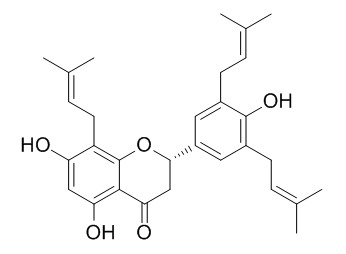5-Hydroxysophoranone
5-Hydroxysophoranone exhibits high antiplasmodial activity against Plasmodium falciparum (IC50=2.5 microg/mL).
Inquire / Order:
manager@chemfaces.com
Technical Inquiries:
service@chemfaces.com
Tel:
+86-27-84237783
Fax:
+86-27-84254680
Address:
1 Building, No. 83, CheCheng Rd., Wuhan Economic and Technological Development Zone, Wuhan, Hubei 430056, PRC
Providing storage is as stated on the product vial and the vial is kept tightly sealed, the product can be stored for up to
24 months(2-8C).
Wherever possible, you should prepare and use solutions on the same day. However, if you need to make up stock solutions in advance, we recommend that you store the solution as aliquots in tightly sealed vials at -20C. Generally, these will be useable for up to two weeks. Before use, and prior to opening the vial we recommend that you allow your product to equilibrate to room temperature for at least 1 hour.
Need more advice on solubility, usage and handling? Please email to: service@chemfaces.com
The packaging of the product may have turned upside down during transportation, resulting in the natural compounds adhering to the neck or cap of the vial. take the vial out of its packaging and gently shake to let the compounds fall to the bottom of the vial. for liquid products, centrifuge at 200-500 RPM to gather the liquid at the bottom of the vial. try to avoid loss or contamination during handling.
Molecules.2020, 25(23):5609.
Cell Chem Biol.2019, 26(1):27-34
Biol Pharm Bull.2018, 41(11):1685-1693
Appl. Sci. 2021, 11(8),3437.
Front Cell Dev Biol.2020, 8:32.
Journal of Phytopathology2021, 169,Issue11-12.
Phytother Res.2015, 29(7):1088-96
Molecules.2022, 27(4):1412.
Biomolecules.2023, 13(2):227.
The Journal of Internal Korean Medicine2015, 36(4):486-497
Related and Featured Products
Arch Pharm Res. 2007 Nov;30(11):1398-403.
Biological activities of the chemical constituents of Erythrina stricta and Erythrina subumbrans.[Pubmed:
18087807]
METHODS AND RESULTS:
Phytochemical investigation of the hexane and CH2Cl2 extracts of Erythrina stricta roots and E. subumbrans stems led to the isolation of six pterocarpans, one flavanone, one isoflavone, two alkaloids, five triterpenes, six steroids and alkyl trans-ferulates.
The structures of all known compounds were determined on the basis of spectroscopic evidence. Sophoradiol (15), a mixture of stigmast-4-en-3-one (19) and stigmasta-4,22-dien-3-one (20), lupeol (21), cycloeucalenol (22), a mixture of 3beta-hydroxystigmast-5-en-7-one (23) and 3beta-hydroxystigmast-5,22-dien-7-one (24) and melilotigenin C (25) were first isolated from the genus Erythrina. The isolated compounds were evaluated for antiplasmodial activity, antimycobacterial activity and cytotoxicity.
CONCLUSIONS:
Among the tested compounds, 5-Hydroxysophoranone (8) exhibited the highest antiplasmodial activity against Plasmodium falciparum (IC50 2.5 microg/mL). Compound 8, erystagallin A (5), erycristagallin (7) and erysubin F (10) showed the same level of antimycobacterial activity against Mycobacterium tuberculosis (MIC 12.5 microg/mL). For cytotoxicity, erybraedin A (2) showed the highest activity against the NCI-H187 and BC cells (IC50 2.1 and 2.9 microg/mL, respectively), whereas 10 exhibited the highest activity against the KB cells (IC50 4.5 microg/mL).
J Ethnopharmacol. 2007 Mar 1;110(1):171-5.
Antibacterial pterocarpans from Erythrina subumbrans.[Pubmed:
17055201 ]
METHODS AND RESULTS:
Seven pterocarpans, erybraedin B (1), erybraedin A (2), phaseollin (3), erythrabyssin II (4), erystagallin A (5), erythrabissin-1 (6) and erycristagallin (7), two flavanones, 5-Hydroxysophoranone (8) and glabrol (9), and one isoflavone, erysubin F (10), were isolated from the stems of Erythrina subumbrans (Leguminosae). Their structures were identified by means of spectroscopy. This is the first report of the isolation of the non-alkaloidal compounds from Erythrina subumbrans and the observed dehydration of 6a-hydroxypterocarpans 5 and 6 in CDCl(3) to the corresponding pterocarpenes 11 and 12, respectively. Compounds 8 and 9 were isolated for the first time from the genus Erythrina. Compounds 2 and 4 exhibited the highest degree of activity against Streptococcus strains with an MIC range of 0.78-1.56 microg/ml, whereas compound 7 exhibited the highest degree of activity against Staphylococcus strains, including drug-resistant strains (MRSA and VRSA), with an MIC range of 0.39-1.56 microg/ml. Interestingly, compounds 2, 4, 5 and 7 were more active against several strains of Streptococcus and Staphylococcus than the standard antibiotics vancomycin and oxacillin. Compound 7 showed the highest level of activity against all VRSA strains tested, with an MIC range of 0.39-1.56 microg/ml, which were resistant to both antibiotics.
CONCLUSIONS:
These compounds may prove to be potent phytochemical agents for antibacterial activity, especially against the MRSA and VRSA strains.



